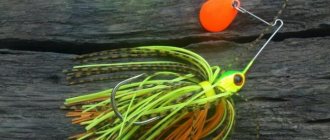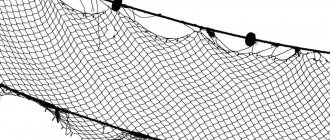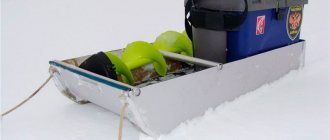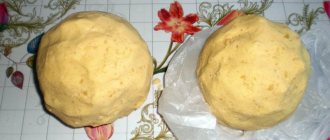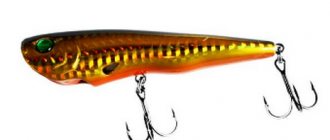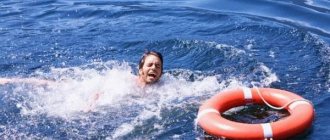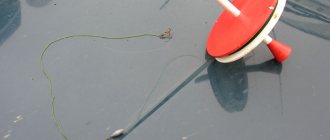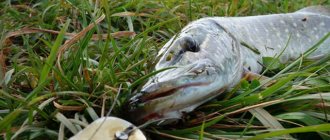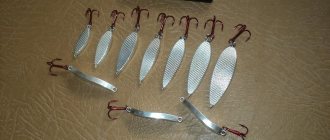Over the years, inquisitive fishermen have invented different types of baits and developed various recipes for unique baits for catching fish. At the same time, fishermen studied the behavior patterns of certain fishing objects and the influence of weather on it. As a result of such research, the modern market is filled with a large assortment of fish baits, among which a special place is given to the spinnerbait for pike.
Spinnerbait
What is a spinnerbait for fishing?
The spinnerbait is an original fishing bait that was invented 100 years ago in the USA, and appeared in our country relatively recently. The name of this bait is derived from the English words spinner - rotating spoon and bait - bait.
The spinnerbait has gained great popularity due to its high catchability and maneuverability, since these are the qualities that make it possible to use it in shallow water in standing water with dense vegetation. Predatory fish, including pike, like to ambush in such places.
The high permeability of the spinnerbait makes it more competitive in comparison with other baits made of plastic and foam rubber, and its attractive appearance and structure make it easy to lure toothy pike and ensure high bite results.
The design of a spinnerbait for pike is quite unusual - it is a thin steel rod, bent in the shape of an L or a rocker. This shape allows you to reduce snags in areas overgrown with thick grass.
Along the edges of the rod and at its bend there are loops, to one of which a fishing line is attached. A rotating petal, which plays the role of bait, and a hook, which is sometimes decorated with bright silicone plumage, are attached to the remaining loops. Sometimes 2 or more petals (spinners) and a silicone “skirt” are attached to the spinnerbait in order to better attract fish. Also, the “skirt” increases the permeability of this fishing bait through overgrown areas of the reservoir.
Most popular models
Spinnerbaits are produced by a huge number of companies; below we present the most famous, time-tested and tested by anglers:
- NORMAN LURES.
- NEWEREA 2000.
- DAM PIEKE SPINNER.
- Bomber Mini-Whacker.
- Booyah Moontalker.
Read more
Technoplankton recipes for the press for catching silver carp
You should choose a model based on your preferences, budget, and functionality.
Today, a huge number of companies produce fishing baits
Types of spinnerbaits and their features
When examining different types of spinnerbaits from different manufacturers, it becomes clear that almost all of them are the same size. This is explained by the fact that the efficiency and excellent qualities of this bait allow you to not change anything in its shape and dimensions, and it works great when catching fish of different sizes.
Photo: Spinnerbait
Nevertheless, spinnerbaits can differ in the shape and number of petals, in the design of the rocker arm, in the type of head, as well as in the material and color of the “skirt”:
- Most fishermen use classic spinnerbaits with different blade shapes, among which “French”, “Willow Leaf”, “Colorado” and others are especially notable.
- There are also variants of spinnerbaits in which the petal is attached with a fastener, and there are models with a rigid fixation of the hook on the rod.
- Many spinnerbaits differ from each other in design elements, for example they come with 2 or 3 blades, which can be arranged in different sequences and be of different sizes.
- Some models, “buzz baits,” are equipped with a kind of “propeller” that allows the bait to be at the surface of the water and create a slight noise that attracts predatory fish.
Buzz-bait
- Spinnerbaits can be distinguished from each other by their weight heads, which can vary in weight and shape. The heads come in the shape of a fish, boat, ski and others; the main material for their manufacture is lead.
Micro spinnerbaits
These are small baits with small petals, which are usually used by small fish, usually their weight does not exceed 3.5 grams. Despite their small size, micro spinnerbaits (or mini spinnerbaits) are equipped with strong wire, fly well and can be used with any type of fishing.
Varieties
There are many varieties that differ in appearance and shape. Distinctive features may be the weight, size, material of the petal, color, quantity, size of the petals of the spinner, the shape of the rocker arm, the types of attachments on the “skirt” hook.
There are several main types:
- standard spinnerbaits with one blade and a tuft of silicone located on a jig head with a hook;
- baits with several petals located one after another on the same axis of the rocker;
- spinnerbaits-“catchers”, in which the bunch of rubber on the hook is replaced with silicone bait: twister, vibrotail, and other baits;
- Bassbait is a large spinnerbait for pike. Instead of a petal, a propeller with a low rotation speed is installed. Bassbaits follow the surface of the water, leaving behind small breakers with a characteristic sound that quickly spreads through the water. They can be considered highly specialized, used exclusively for pike fishing.
There are three modifications of the petal shape:
- Willowleaf - long and narrow, resembling a willow leaf;
- Colorado - wide, rounded;
- Indiana - similar in shape to the Colorado, but longer and somewhat narrower.
They can be painted or galvanized, smooth or grooved.
Despite the clear definition of this bait, spinnerbaits still differ from each other in design features, sizes, colors and other indicators. By design they are divided into the following categories:
- A classic spinnerbait with one or several blades and a weight rigidly attached to the shoulder of the rocker with a silicone “skirt” or an octopus, twister or creature type bait.
- A spinnerbait with a propeller or turbine installed instead of a blade. This bait is called a bassbait. It is distinguished by stable play and the ability to carry out wave-like wiring. During pauses, the petal continues to rotate, creating damped vibrations that are attractive to pike.
- Catcher. It differs from the classic spinnerbait in that, instead of a rigidly fixed load, it is equipped with a jig head suspended by a loop and having a sufficient degree of freedom. It is customary to attach a vibrotail or twister to the hook, less often a creature, an octopus or a crustacean.
The size of a spinnerbait for pike should be medium or large. Small perch baits are not used, since with them you can count on catching only a small “pencil” or a striped robber, which is of no interest to an angler eager to catch a spotted beast.
Advice! The color of the spinnerbait is chosen similarly to other types of bait. In muddy water it is advisable to give preference to provocative tones, and in clear water - natural ones. Dark shades can be considered universal, as they attract pike equally well in any conditions.
We invite you to familiarize yourself with: Prohibited gear and types of fishing
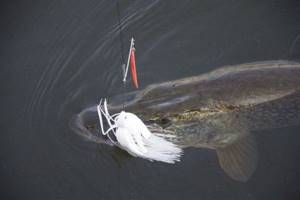
Most often in our conditions, baits with the number of petals from one to two are used. However, there are models with three, four and even five blades, but they are in little demand among domestic spinning players. The shape of the petals of a spinnerbait can be elongated, oval or round. The first ones work better in currents, the second ones are considered universal, and the third ones are intended for closed reservoirs.
Where and when to use
This bait is associated with fishing in areas that are saturated with algae and snags, because these are the places that attract predators. Although in places covered with mud, not a single hook-free bait will help.
It is best to use spinnerbaits in small open reservoirs overgrown with grass, reeds or water lilies - those places where pike most often hunt small fish, attacking them from the thickets.
Trophy pike caught with a spinning rod on a spinnerbait
Spring, summer, autumn
At times it happens that the pike even kicks the prey upward itself. Such habits are typical for pike in the summer. Many fishermen note that pike are more willing to use a spinnerbait when the grass in the pond has finished growing.
In spring, the spinnerbait begins to work only in May, since it is at this time that the water warms up and the pike becomes active.
In the fall, just before the freeze-up, there are a lot of pike in the reservoirs, but they are not so easy to catch with bait. Experienced fishermen sail a boat into the thickets and drive the pike into a clear space by striking the water with oars.
Winter pike fishing with ratlins - vibs
They started catching pike with ratlins in Russia relatively recently. Initially, the summer bait was abandoned under water thanks to enthusiastic experimenters and marketers from fishing companies.
Initially, this whole trick was invented for catching pike perch at the moment when people stopped buying and believing in Williams spinners. That’s when the Ratlins flew into the water. And taking into account the fact that there are many of them in the model range of every Japanese company, there should have been a lot of sales.
Personally, I was the last to believe in ratlins. This process is too complicated. With what? Each ratlin requires individual settings. Each weight and type has its own fishing rod, its own amplitude of play, working depth, and even time of year. What about the colors? Too many of them. From a financial point of view, it is too expensive to comprehend such a science.
But still, how to catch? I'll tell you.
The first thing I notice is the size. I have long said and will continue to say that the larger the bait, the larger the pike.
I consider the DUO VIB to be the standard for pike vibration engineering. Pay attention to the size. This is how VIB should be!
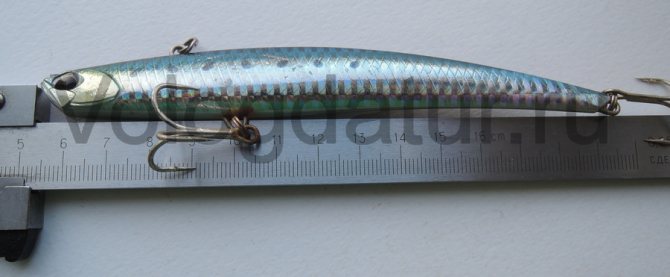
If this size seems huge to you, then take a little smaller. Here are some options from Shimano.
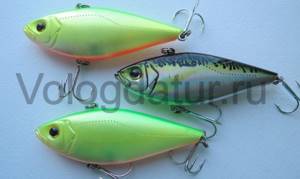
And even less. Classics of the genre! Old and good Maria. The easiest to operate and the most reliable.
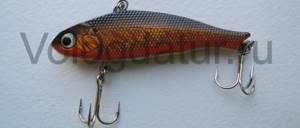
The "intermediate" size can be found in the Cultiva list. Very good and working vibe in the “right” color.
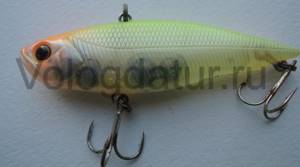
There are also some unusual vibes from Lacke craft Cymbal Vib. A very unusual bait with its own game. Its peculiarity is that it consists of two halves connected together.
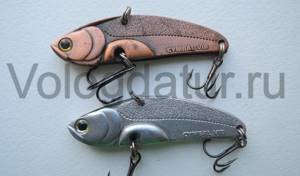
The basic rule for all baits: the greater the weight, the greater the depth.
The list of photographs of winter ratlins can be continued endlessly. Our article will turn into a collection of vibes.
Do not forget that there can be several versions: quiet and noisy. They can be narrow or wide in shape.
I believe that to begin with, you can buy 5 pieces on the secondary market, and if it works out, then continue, but if not, then no.
How to catch pike with a spinnerbait
When it comes to pike, a spinnerbait with 2 silver petals and a white “skirt” is most often used to catch it. This bait is suitable for active pike; if it is sluggish and passive, then it is easier to catch it with a spinnerbait with one blade.
The most effective fishing for pike with a spinnerbait looks like this: you need to carefully wind the braid onto the reel, gently shaking the tip of the rod. With such movements, the “skirt” will make contractions like the tentacles of an octopus, and the petals will rotate alternately, which will certainly attract the pike, and it will rush to the bait without hesitation.
Photo: Spinnerbait
Technique for retrieving a spinnerbait
The spinnerbait allows the angler to use various retrieve techniques. The following types are distinguished:
- Uniform retrieving is the simplest fishing method, in which its speed can be medium or minimal. This method is suitable for fishing from boats or steep banks.
- Step retrieving is a technique that involves touching the bottom when the bait falls. During reeling, the bait rises above the bottom, producing intense rotational movements.
- Shaking is the performance of sharp and impetuous movements with a fishing rod while reeling in the fishing line.
- Stop and Go wiring is in many ways similar to step animation, but is performed without touching the bottom.
Spinnerbait for pike, which one is better?
The most popular lures for pike are spinnerbaits of white, silver, black and red colors, since they work well in both clear and muddy water.
Specimens with a copper petal and a yellow silicone “skirt” are ideal for catching pike in clear water.
Pike attacks spinnerbait
In order to lure pike in places where grass and algae accumulate, as well as in muddy water, you can choose models with nickel-plated blades or fluorescent spinnerbaits.
For fishing at depth, heavy spinnerbaits are most often used, which sink quickly and do not create resistance in the water. When choosing a spinnerbait by weight, you should take into account the number of petals, their shape, as well as the depth of the reservoir and wiring technique. Light baits are more often used at the surface of the water, while heavy ones are good for fishing on the bottom.
Bait device
Spinnerbait - as a bait for pike, has been known for about a hundred years, but in the vastness of our country, it began to be used relatively recently.
However, having high catching characteristics, the bait quickly gained popularity and continues to steadily replenish the ranks of its fans. How does a spinnerbait differ so favorably from classic spinners - spinners and spinners? Let's try to figure it out. Including a spinnerbait in the list of lures that you just need to cast and pull is somewhat incorrect. This is the same individual and complex representative of fishing equipment as the crank. Even though they classify him as an idiotbates. The simplicity of the design does not give reason to treat it lightly. When you try to purposefully catch our predators, you will understand what I’m talking about. Here, difficulties may arise both with casting and with persuading fish.
But despite the variety of possibilities for animation, basic spinnerbait wiring still involves two options:
- Equal wiring.
- Jig step.
Each of them, with its own options, can be used in completely different conditions. At the same time, catching pike and perch with a spinnerbait becomes an exciting activity comparable to fishing with a wobbler. The same excitement and adrenaline.
No tail, no scales. Regards, Oleg
Fishing with a spinnerbait leaves 2 main fishing options - a traditional technique and an adapted one.
The traditional method of presenting such bait is best used while being at an elevation from the water: from a steep steep bank, bridge or boat. Use a light (3-7 g) bait with a thin, medium-sized petal. The spinnerbait is lowered into the water, periodically stopping the line and allowing the bait to hang, while the tip of the rod makes slow oscillatory movements, causing the silicone, attractive to pike, to slowly open and gather, reminiscent of squid tentacles. Thanks to the windage, the bait sinks to the bottom slowly, the petal in its upper part actively rotates, attracting a predator from afar with its shine.
When the spinnerbait reaches the bottom, the angler lifts and lowers the rod tip, tapping the jig head against the bottom and raising mud. Then the line is slowly wound onto the reel, stopping periodically and continuing to swing the bait. The rubber band is attacked by a predator most often at the moment of launch or in the first third of the water from the bottom.
Another wiring method is adapted. In this case, the bait head is used heavier than in the previous one, and the petal is larger and thicker. A silicone vibrotail or twister is attached to the hook.
After casting, the angler waits until the spinnerbait touches the bottom, then the excess line is wound onto the reel and the retrieve begins. It occurs at a medium-slow pace, with long stops to swing the bait in the water. When reeling, the rotation of the petal lifts the bait from the bottom, sometimes quite high in the water column, and during pauses the spinnerbait slowly sinks, while the petal continues to rotate and attracts fish.
Bites from perch and pike with this method of fishing can happen at any moment, so you should not relax your attention, all the time reeling in excess fishing line and not letting it sag. Immediately after the attack, the pike will spit out a rather large wire frame, so hooking should occur directly during the bite.
The depth and quality of the wiring are decisively influenced by the shape and size of the petals. Thus, the Colorado petals have the greatest lifting force, but they overcome grass thickets worse than others due to their width. This means that when fishing, they should be placed along the edges of islands of aquatic vegetation, and for casting into thickets it is better to use “willow leaf” type petals.
Here are the features of the 3 main types of spinnerbait blades:
- Colorado. Thanks to their wide, rounded shape, they transmit maximum vibration to the bait and are perceived from afar by the lateral line of the predator. Used mainly in muddy water.
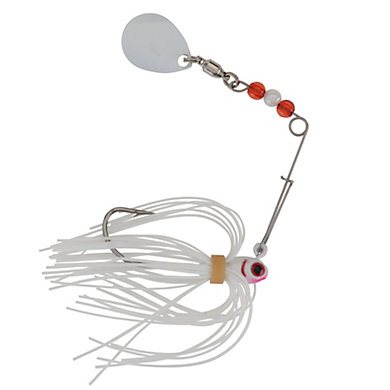
- Indiana. Also rounded, but more elongated in shape, the petals are the most practical, optimal option. They have average lifting force, average vibration, and are applicable in deep and shallow water.
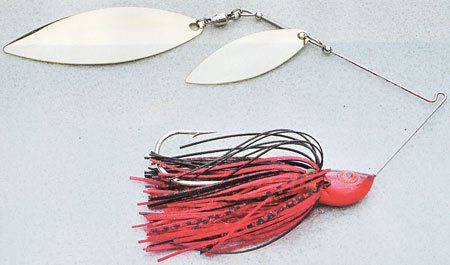
- “Willow leaf” is a form for fishing at depth. Thanks to the high rotation speed, these petals quickly release the bait to the bottom, attracting a predator from afar with its shine.
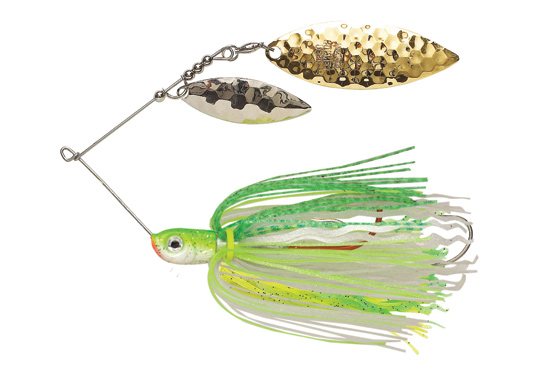
Silicone for pike has a wide range of colors; in each individual case, the fisherman himself chooses the appropriate option, but there are 2 recommendations: in sunny weather and in clear water, use a white skirt, and in cloudy weather or in muddy water, the most catchy spinnerbaits have dark skirts shades.
A standard spinnerbait consists of two main parts:
- “skirt” - a hook with a weight or a jig head with feathering in the form of a bunch of rubber (silicone). The hook is hidden in the “skirt”. Instead of feathers, a twister, vibrotail, made of silicone can be used. The jig head must impart a certain weight and maintain its position in the water column;
- concave-convex petal, reminiscent of the petal of a spinner. This component is called the spinnerbait lure. Unlike a regular spinner, the petal plays a different role here. It creates a vibration that is transmitted to the second part - the “skirt”, which the fish grabs. The petal should rotate easily, create vibration, sound vibrations and a trail of bubbles behind it.
Both elements are connected at an angle of 90 degrees with a special rocker arm made of thin wire. The rocker arm must have a significant degree of rigidity and elasticity, due to which the entire structure of the tackle is supported and the vibration of the spoon petal is transmitted to the “skirt”. The rocker also helps the bait pass through areas that are heavily overgrown with grass, “paving the way” for the remaining parts.
There are no universal models of spinnerbaits, as well as other artificial spinning lures. Only by experience can a specific shape, petal color and silicone of the scout bait be selected, which will help to examine an unfamiliar body of water for predator activity.
When choosing, you should adhere to the following rules:
- the weight of the load depends on the depth of the line at the fishing point;
- for places with significant fishing pressure, it is better to choose compact baits;
- the color, size of the petal and silicone depend on the transparency of the water, lighting, and type of fish.
We suggest you read: Catching carp in the fall: tackle and bait
Upgrading a spinnerbait often becomes a necessity when fishing if the “skirt” is torn off by a pike. Therefore, the presence of spare material and the components of this bait is mandatory.
It is possible to change the size, shape of the petals, and their color using both industrial and hand-made petals. The petals of the bait can be painted in different colors. Petals with copper, gold, and silver hues performed well without coloring.
The spinnerbait is universal, suitable for catching all predators of our latitudes. A fishing tackle equipped with a spinnerbait makes it possible to use it in places where most baits completely lose their effectiveness; to stay with your catch where other anglers will only regret the lost spoons and wobblers.
How to properly attach a spinnerbait to a fishing line on a pike, installation
In order to catch pike in the fronds from the shore, you will need a rod at least 2.7 meters long, and if you fish from a boat, you can get by with a 2-meter spinning rod. A reel with a spool capacity of 2000-3000, a fishing line with a diameter of 0.1-0.6 mm and a metal leader is attached to the spinning rod.
The bait is attached to the fishing line using a loop located on the rocker arm. The loop can be open or rolled into a ring (closed); this determines which knot to tie the fishing line to the bait with - a palomar (see photo below) or by fastening a carabiner from the main fishing line.
Knot Palomar or Palomar
Light-weight spinnerbaits do not require special gear; monofilament fishing line, a short rod and metal leaders are sufficient. Before fixing the bait, you should inspect it for defects, for example, an even slope of the arc or an acute angle for better sliding of the spinnerbait along the bottom of the reservoir.
Pike caught on a spinnerbait
Which spinner to choose for pike fishing in winter
Which brace should I choose for pike, or a universal brace? I have always believed that nothing is universal. But in the case of a brace, there is one optimal size - 130 mm. In 30 years of winter fishing there has never been a case when a caught fish did not get through. Just 10 years ago, I couldn’t find any alternative to Scandinavian drills. The euro exchange rate was reasonable and spare knives were available. Now everything has changed. Swedes are expensive, spare knives are even more expensive. Now the Chinese ones have appeared, but time will tell.
I recommend taking the regular Helios Tonar. So many things have already passed through my hands, but this twist impressed me. With the exception of the always falling apart top handle - no problem! Spare knives can be bought at “any stall”!
If you have taken the path of a trophy winner or will go to the holes every day, then it is better to buy 150 mm.
I am not dissuading anyone at all; if there is an opportunity, then of course it is better to buy a good Scandinavian and use it. It’s just that times are different, not many people can easily pay 10,000 rubles for a brace.
Popular manufacturers, prices
Any bait that is used when fishing among algae implies a consumable material, so its price is important. Many companies producing spinnerbaits are constantly improving the design and improving the materials used to make baits, so the quality-price ratio is quite justified.
Depending on the size, number of petals, materials used in the manufacture and manufacturer, the cost of spinnerbaits varies from 200 to 1600 rubles.
- Kosadaka (Kosadaka). It is a product of the Japanese company of the same name and is a copy of the 2014 model bait, invented in the USA. The price of such a spinnerbait is 300 rubles.
- Lucky John (Lucky John). The cost of spinnerbaits of this brand ranges from 250 to 500 rubles.
- Megabass (Megabass). A Japanese fishing tackle manufacturer that occupies a leading position in the production of effective lures. Megabass brand spinnerbaits cost about 970-1050 rubles.
- Lucky Craft (Lucky Craft). A transnational company that produces and markets fishing gear in the American and Japanese markets. The company also produces spinnerbaits of various sizes and designs. The estimated cost of such baits ranges from 200 to 850 rubles per 1 piece. There are also compact copies for 80 rubles.
- Booyah (Buyah). One of the largest manufacturers of spinnerbaits, whose parent company is based in the USA. Booyah baits are presented in a fairly wide range, and their cost is 400-600 rubles.
You can also find spinnerbaits on sale from the following manufacturers: Blue Fox, Daiwa, Storm, Balzer, Strike King, Ever Green, Berkley, Grauvell, Yakima Bait, Strike Pro, Deps, Savage Gear, Smith, Z-man, C'ultiva and other. Inexpensive replicas can be bought on Aliexpress.
Wiring
This type of bait is active. It should be done quickly so that the fish does not have time to “come to their senses”, or even lose interest altogether. It will be even better if algae cling along the route - it will be an additional incentive.
Read more
How to catch perch using a balance beam?
Two wiring techniques are used:
- uniform;
- wavy.

Uniform wiring is used when catching active fish. When the pike is hungry, using this type of braid will be quite enough to provoke a good bite. The best results can be achieved using this technique if you drive the spinnerbait into the bottom layer and guide it so that it periodically touches the bottom.
Spinnerbaits for pike also require a wave-like retrieve technique. In this case, you need to unwind the line unevenly - manually, sometimes faster, sometimes slower.
Thus, the bait will move in waves - first quickly along the surface, then slowing down and sinking to the bottom. Due to the trajectory of movement, large fish are attracted.
There is another option - wave-like wiring using a fishing rod. The reel handle rotates evenly, the spinning rod swings smoothly up/down.
Video: Catching pike with a spinnerbait
A spinnerbait for pike is considered a fairly catchy bait, provided that it is used by an experienced angler. Don’t be afraid to experiment with individual parts of this type of bait and use different types of wiring. Using such an effective bait, any angler will be able to develop his own technique for catching predatory fish.
Views: 855
Similar articles:
- Topwaters for pike. Where, when and how to fish with topwaters, their advantages and disadvantages. The choice of baits is huge. They can be superficial and deep, large...
- Catching pike with unhooked hooks in grass and snags Pike is a predatory fish that lives and hunts in hard-to-reach...
- Catching pike in the grass. Grass pike for spinning Late spring, summer, early autumn - at this time there are small...
- Suspender wobbler: what is it and how to catch with them What to do if the fish does not want to hunt or is chasing the bait…
About
Spinbait fishing

Wiring
This type of bait is more designed for even retrieving, otherwise it will lose its advantages. This can be either slow or fast retrieve, especially if the fish is actively hunting.
Fishing place
Predatory fish, such as pike, can be found either in snags or in thickets of aquatic vegetation, from where the movements of a potential victim can be observed. Therefore, it is better to cast the bait near these places and move the bait parallel to the thickets or snags.
Tackle
As a rule, a rod is chosen in such a way that the hooking is effective. This can be a medium-fast or fast action rod. Such a rod will help you quickly deal with a predator, preventing him from taking the tackle into the grass or snags. The rod can have a length from 2 to 2.5 meters. If you have a good reel, this is quite enough.
The fisherman is an expert. Spinnerbaits
